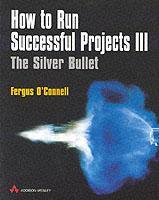How to run successful projects III : the silver bullet
Langue : Anglais
Auteur : O'CONNELL Fergus

This third edition compares the "ten steps" of structured project management with other methodologies (including PRINCE). This volume reveals how to do the least amount of project management possible and still be sure of a successful outcome and discusses how to identify and monitor your project"s "vital signs". It has a quick and easy way to assess project plans and proposals ensuring that you catch potential disasters before they happen. It also includes daily weekly, and monthly routines for any project manager to incorporate structured project management seamlessly into their working lives, and offers a new comprehensive self-study course in MS Project 2000.
Contents
Preface to the new edition xvii
Preface to the second edition xviii
Preface to the first edition xxi
About the author xxiii
Introduction xxiv
PART 1
Analysing and planning projects 1
The nature of projects 1
The project as a journey 2
The project as a state change 2
Structured project management: the Ten Steps 2
CHAPTER 1
Step 1: visualise the goal, set your eyes on the prize 7
Introduction 7
Identifying the goal 7
Defining the goal 7
Tighten the definition of the goal 7
Start the planning process 8
The reason for the goal 8
Motivating the team 9
Changes to the goal and change control 9
Ways of visualising the goal 11
Visualisation checklist 11
The and-they-all-lived-happily-ever-after method 12
Application to software engineering 13
PSI contribution 16
CHAPTER 2
Step 2: make a list of the jobs to be done 18
Introduction 18
Making a checklist 19
Identifying the jobs with Form 1 20
Application to software engineering 20
PSI contribution 27
CHAPTER 3
Step 3: there must be one leader 37
Introduction 37
Case Study 1 38
Case Study 2 38
Case Study 3 39
Case Study 4 39
A role model 39
Application to software engineering 40
PSI contribution 42
CHAPTER 4
Step 4: assign people to jobs 43
Introduction 43
Each job has a name 43
People s other commitments 44
Monolithic team or flat structure 47
Hierarchy or team structure 47
Maximise strengths 48
Assigning people to jobs 48
Category 1 48
Category 2 49
Category 3 49
Category 4 49
Category 5 50
Case Study 5 50
Assigning people to jobs with Form 2 51
Application to software engineering 51
PSI contribution 52
CHAPTER 5
Step 5: manage expectations, allow a margin for error, have a fallback position 57
Introduction 57
Contingency: allow a margin for error, have a fallback position 57
Explicit or hidden contingency 57
Finding contingency 59
Manage expectations 60
A word on committing 62
Case Study 6: manage expectations 63
Case Study 7: allow a margin for error 64
Case Study 8: have a fallback position 64
Case Study 9 65
Application to software engineering 65
PSI contribution 67
PART 2
Reviewing and implementing the plan, achieving the goal 69
Introduction 69
Application to software engineering 71
Steps 1 5 Significance of PSI at this point 73
CHAPTER 6
Step
Provides a quick and easy way to assess project plans and proposalsHow to identify and monitor your project's 'vital signs'
The comparison of the Ten Steps with the PRINCE methodology has been extended to a comparison with any methodology.
A comprehensive,self-study course in MS Project 2000
Date de parution : 10-2001
Ouvrage de 322 p.
18.8x23.4 cm
Thème de How to run successful projects III : the silver bullet :
© 2024 LAVOISIER S.A.S.
